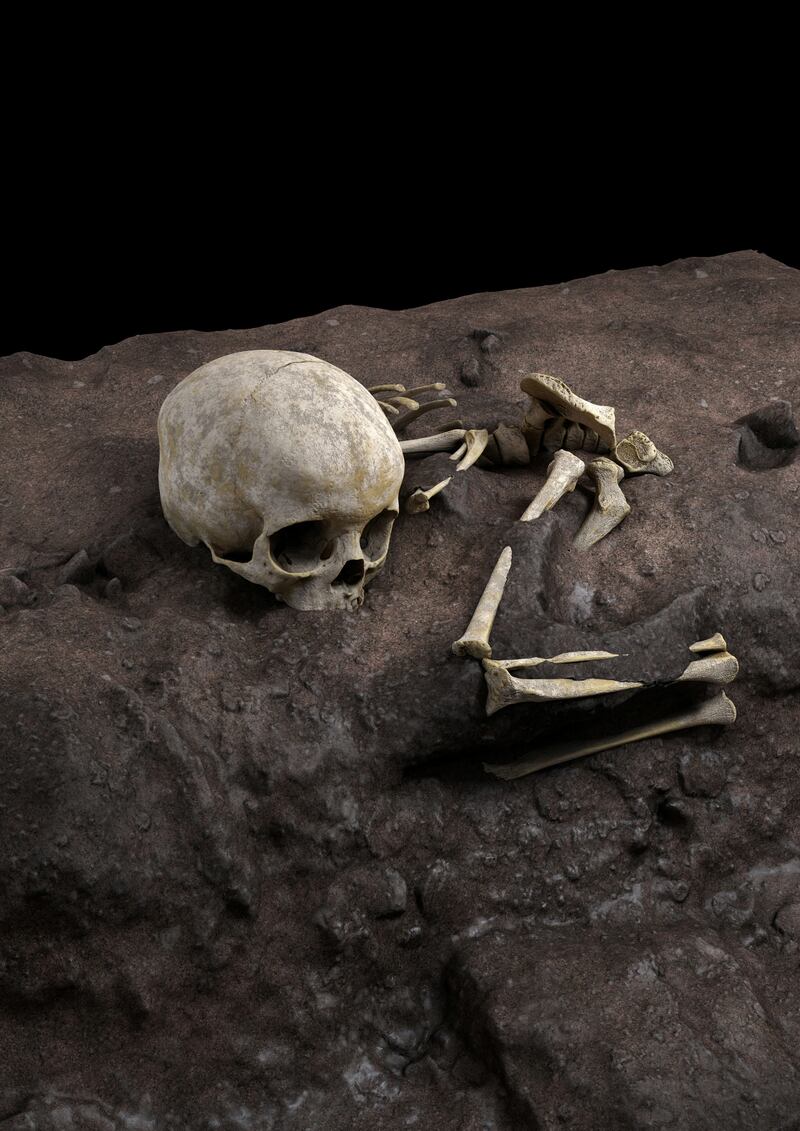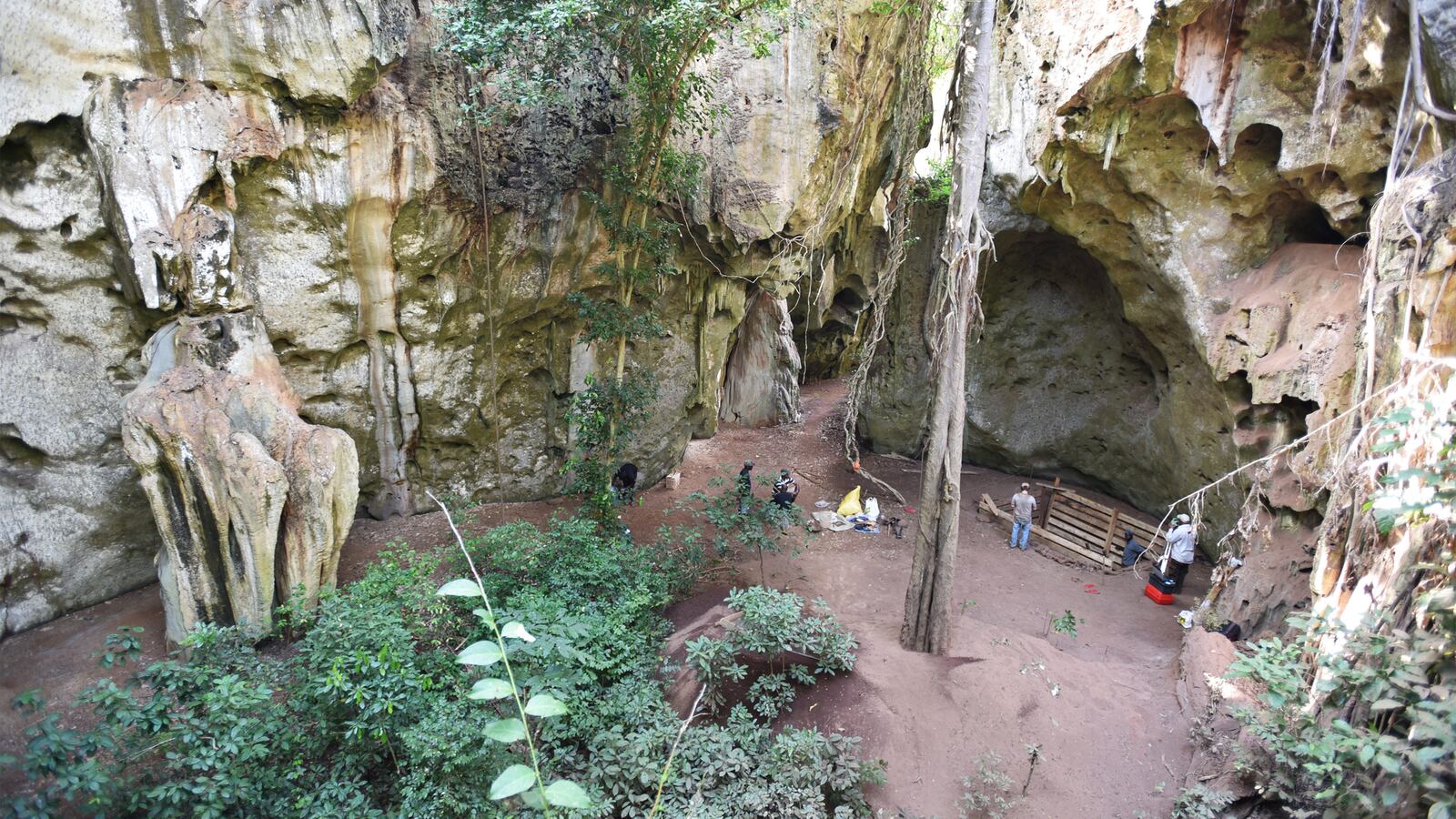Archaeologists in Kenya have discovered the oldest human burial in Africa. The almost 80,000-year-old grave was discovered by researchers in the opening to a cave on the coast of Kenya’s tropical uplands. Scientists believe that they belonged to a child aged between 2 and 3 years old. The fragile remains—which have been named “Mtoto” after the Swahili word for “child”—promise to tell us more about human social behavior, organization, and cognition in the Middle Stone Age.
The discovery of the partial skeleton in the Panga ya Saidi cave north of Mombasa was made in 2013 by a team drawn from the National Museums of Kenya in Nairobi and the Max Planck Institute in Germany. The collaborative project involved further study at the Conservation and Restoration laboratories at the National Research Center on Human Evolution in Spain. The excavation itself proved to be a challenge as the bones were so degraded that they could easily have turned to dust during removal. The solution was to excavate a pit around the bones, fill it with plaster, and then transport the encased remains to the National Museums of Kenya for analysis. The remains were later carried on flights first to Jena, Germany, and later to Burgos in Spain. The results of this lengthy study were published this week in the prestigious journal Nature.
What the analysis revealed was that the remains came from a young Homo sapiens roughly the age of a toddler. While older H. sapiens burials have been identified in the Levant and Europe, this is the first known example of a deliberate burial. The child had been buried in a kind of foetal position with their knees tucked under their chin. The tilt of their head suggested that it had once been supported by some kind of “pillow.” Though the material that encased the child has long since disintegrated, experts think that they were originally wrapped in a material (likely animal skins or some kind of plant fibers).
The most striking discovery is the positioning of the body; it is suggestive of a deliberate and careful burial rather than just disposal. Bodies that were exposed often reveal signs of damage and interference: cracks, signs of animal disturbance, or weather-related smoothing. But Mtoto’s remains had only minimally been displaced and their anatomy was remarkably intact. Technical analysis of the soil that surrounded the Kenyan child’s remains supports the idea that the child was purposefully buried. All in all, the scientists conclude, “This evidence supports the idea that there was more elaborated involvement of the community in the funerary rite, rather than structured abandonment of a corpse or a happenstance burial.” Nicole Boivin, a professor of archeology at the Max Planck Institute told the Guardian that “It’s incredibly rare that we gain access to such a snapshot of a moment in time, especially one so very ancient.”

The remains of a child roughly age 3 who lived about 78,000 years ago and was found in a burial pit at a cave site in Kenya called Panga ya Saidi, the oldest-known human burial in Africa, are seen in an undated virtual reconstruction.
JORGE GONZALEZ/ELENA SANTOSThe rarity of the find may be connected to the youth of the subject; while paleolithic hunter-gatherers were accustomed to death as a natural part of life, the deaths of infants and children may have been distinctive and particularly tragic. Boivin said: “The burial takes us back to a very sad moment—one that despite the vast time separating us, we can understand as humans.” Even though infant mortality rates in the paleolithic and ancient world were high, the death of this 3-year-old may have had a distinctive quality to it.
The experience of grief and the practice of deliberately burying one’s dead speaks not just to pervasive and cross-cultural human experiences, but also to the cognitive capacity of early humans in the Middle Stone Age. Though it takes many forms, burial is one of the most ubiquitous practices of ancient and modern societies. As the anthropologist W. H. R. Rivers remarked over a century ago, “Few customs of mankind take so firm a hold of his imagination as his modes of disposing of the bodies of the dead.” From the presence of flint tools and animal bones in Neanderthal burials, to the discovery that a 60,000 burial at the Shanidar Cave in Iraq included large numbers of flowers, there is evidence that early humans had ritualized forms of burial (though there are plenty of alternative readings of this evidence). The combination of these elements led anthropologist B. G. Campbell to suggest in his book Humankind Emerging that perhaps paleolithic Iraqis believed that deceased person would be “reborn.”
For the first generations of anthropologists and sociologists, death and burial were one of the clearest signs that early humans had religious beliefs and, thus, also social values. “Burying the bodies of loved ones”, Mary Stiner has written, “is a uniquely human habit…[that] is tied to human capabilities for symbolic expression.” Elephants, chimpanzees, and dolphins all grieve over loved ones and display empathy, says Stiner, but they do not mourn over the length of their lives in the way that Neanderthals do. The similarity of Middle Stone age mourning practices to those of modern humans is taken as a sign that hominins are not so different from us after all. Whether or not the concrete connection between social order, religion, and burial is accurate, the interest in mortuary practices reveals a widely dispersed interest in the meaning and significance of death.
The problem with this kind of speculation when it comes to H. sapiens, however, is that we have so little evidence to go on. In comparison to Neanderthals the evidence for mortuary practices among H. sapiens in Africa is sparse, perhaps because anthropological studies of Africa are relatively recent. As the authors of the study write, “Africa demonstrates a scarcity of mortuary practices over most of the MSA that provides little current support for modern-like conceptions of the afterlife and/or treatment of the dead.”
This is one of the things that makes the discovery of Mtoto so important. We might have assumed that burial was important, but this example of burial “shows that inhumation of the dead is a practice shared by populations living in and out of Africa during the last interglacial period.” The evolution of mortuary practices may not necessarily point to the early development of afterlife beliefs or what we call religion, but they do show our ancestors in a softer light. Despite the representation of early hominins as brutish, their mortuary practices speak to the care they lavished on the bodies of their deceased and an interest in maintain a connection with loved ones. Love expressed through grief, it turns out, is the oldest identifiable human feeling.

